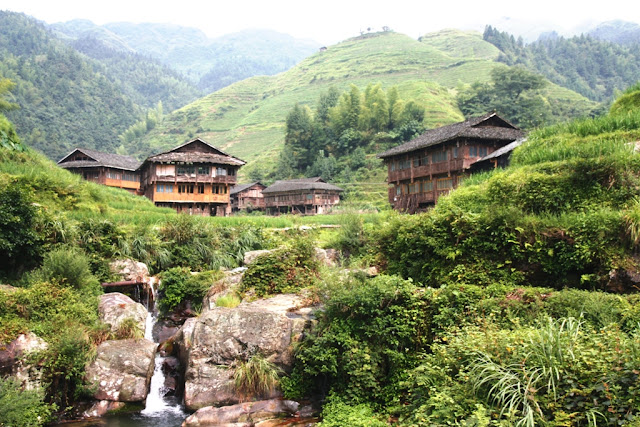Our summer holiday in China began in
Guangzhou. You can read about this
chronological order by starting at this link.
After leaving the Guilin area our destination was up in the mountains and the village of Pingan Zhuang. This was to be our base for two nights and a day's trekking through the Longjie Rice Terraces. To get to the village, up a rather steep hill several hundred metres above the end of the road, one walks. Fortunately there are plenty of local porters to carry your luggage up for a modest fee.
 |
| Pingan Zhuang village |
 |
| Pingan Zhuang |
 |
| Heavy transport |
The village is built on the side of a rather steep hill. The road ends several hundred metres (lower down in altitude) below the village. All supplies are carried in baskets on the ends of bamboo poles or by pack horse. All building supplies are carried or packed in.
Local women supplement their incomes acting as porters for the tourist trade and supplies for the restaurants, hotels etc.
Your luggage is carefully stowed on or in (depending on size) baskets which are held on the backs of the porters by ropes around their heads. We willingly gave them a few extra RMBs to have our cases carried direct to our rooms. It is a steep 30 minute trek up to the village. People can even go up by sedan chair.
Next day we had a 6 hour trek through the rice terraces, home to the Yao People.
 |
| The Longjie rice terraces |
 |
| Good advice |
 |
| One of the Zhongliu (Middle six) villages. |
 |
| Another of the villages, only able to be reached on foot. |
Along the way we met up with a group of Yao women or rather they lay in wait for another group of tourists. The Yao women do not cut their hair and roll it up as seen below. For a small fee they let their hair down!
Their baskets form another part of their "business" containing lots of hand made goods which one bargains for. After parting with a few RMBs and showning them the photos we took we carried on our way. The women waiting for another group to arrive and go through same proceedure, letting their hair down again!
 |
| Another of the Zhongliu villages |
After six hours we arrived at Dazhai where our driver was waiting to take us back to the end of the road and the climb back up to Pinyan Zhuang. This time our leg and calf muscles were screaming at us and protesting at yet more torture!
 |
| One of the local dishes is a rice cooked in bamboo. |
Our last stop in Guilin on the way to the airport to fly to Xi'an was the panda reserve.
 |
| The Giant Panda Ailuropoda melanoleuca |
I detest seeing animals in such enclosures but to see pandas in China, you have no alternative but to see them in such reserves, where they are obviously well cared for though.
 |
| The red panda looks rather vicious. |
Next stop was Xi'an and the Terracotta Army.






















.jpg)





























